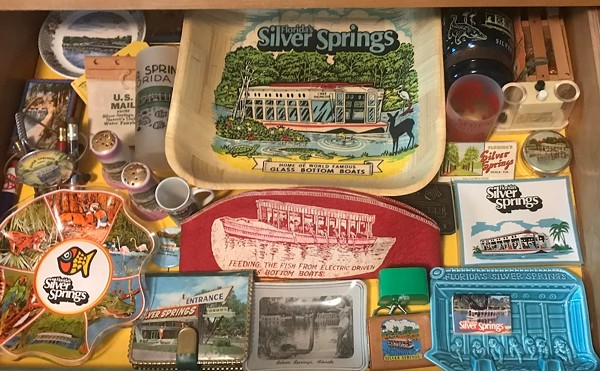As Cunsthaus celebrates its first anniversary since emerging in the Seminole Heights art scene, the collective drops the hammer with a solo exhibition of new photogram works by the conceptual interdisciplinary artist Anthea Behm. Mirror Lamp Hammer explores the function of an image, and how subjective or objective viewpoints collaborate to shape our understanding of the world around us.
Using somewhat banal icons (like a shoe, for instance), the cryptic nature of the work requires some mental flexing for the slow reveal of what’s going on behind the images. Process plays a big role in understanding the complex relationships these camera-less photograms have with the history of photography. Working in the darkroom, Behm exposes black-and-white silver gelatin paper to varying amounts of light to allow for varying shades in color, using stencils as a resist to block out sections. She uses developing solution as a tool for drawing on the paper, creating dark solid lines. It’s then processed as a conventional darkroom photograph through stop bath, the fixer, followed by the wash.
Recalling the photograms made by lower-school children by placing their hands over light-sensitive paper, Behm subverts the traditional form of photography (in its seemingly objective representation of things) by including the gesture of the artist’s hand through her drawings. The hand-drawn lobsters in “Wilendur” trace lineage back to contour drawing — or even monoprinting — in that Behm must trust her hand and is committed to the marks made once the developer is put down. Even the hand-cut edges on the paper, rough and at an angle, emphasize the imperfection of the hand that is typically erased in photography exhibitions.
So are they paintings, drawings or photographs? The artist says they're all of the above. Her work can easily be linked to post-analog painting, since digital tools seem to influence her work (she could work similarly in Photoshop, with its added filters for painterly influence). In addition, she sources the images from the internet. With millions of images for the choosing, her selection is intuitive, yet she tends to focus on fashion, politics or everyday items.
“Rage for Order” depicts the throwaway items we deal with on a daily basis: paper and plastic. Interested in the commodification and movement of goods, she places a grocery bag on top of a tiled background of shipping or gift labels. It’s a sly message: The price we pay for living in a contemporary world is the backhanded “gift” of monuments of plastic waste that won’t decompose for 20 to 1,000 years. It’s not simply about what you see being what you see — a bag — but about mining data, references and representation inferred through context.
The subtle, unexpected piece “Untitled” stands out the most since it breaks away from the found imagery of other pieces in the exhibition and feels more like a candid statement from the artist with its self-declaration: “This is Silver.”
As ephemeral as a quick finger-drawn note upon a steamed glass window, this piece holds an additional layer of intimacy and sincerity. While the photogram truly is created by the reaction of silver from photographic chemicals, it's playful in its disruption of our expectation of the precious metal's uses as jewelry or currency. Not only does her choice speak about consumer culture, it implies the notion of hierarchy (gold is still considered “better”) and the shaky system of value (especially when it comes to prices of technology, jewelry or, for that matter, art).
Though there is no mirror, lamp or hammer in the exhibition, there very well could be. These daily objects and tools more or less act as symbols: mirror as the camera (or the reflection of these images in our minds), the lamp as the light source or illumination of our minds, and the hammer as either the tangibility of these images or the destruction and reformation of photographical conventions.
One might be a bit lost without the wall text, but that seems to be the point: Context, language and conversation matter to the artist in order to consider ordinary things in a different light. Whether toying with the binaries of traditional vs. non-traditional, analog vs. digital, or subjectivity vs. objectivity, the slow reveal of these works is worth the extra effort.


















